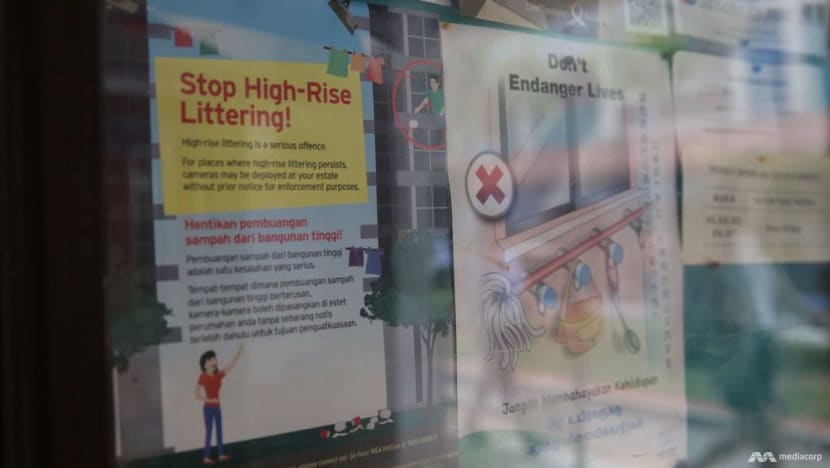Singapore exploring use of AI, drones as surveillance measures to combat high-rise littering
In the coming year, NEA will introduce new operational measures to improve the detection rate of high-rise littering, said Senior Minister for State for Sustainability and the Environment Amy Khor.

A poster advising against high-rise littering seen on the notice board of a housing estate. (File photo: TODAY)

This audio is generated by an AI tool.
SINGAPORE: Authorities are monitoring the "suitability and safety" of technologies such as drone flights as surveillance measures to tackle high-rise littering, said Senior Minister of State for Sustainability and the Environment Amy Khor on Wednesday (Jan 8).
Speaking in parliament, Dr Khor said that the ministry will continue to monitor and explore ways to enhance detection and enforcement capabilities.
These include "keeping pace" with technological developments in video analytics and artificial intelligence, she said.
"In addition, we will continue to strengthen partnerships with communities to develop localised solutions to address high-rise littering, and urge residents to be considerate and not commit such acts, which is an anti-social behaviour that threatens public safety and hygiene," Ms Khor added.
In the coming year, NEA will introduce new operational measures to improve the detection rate, said Dr Khor.
For instance, cameras that can be deployed for longer and have higher resolution will be used. They will also be placed in more "covert locations".
She was responding to questions from various Members of Parliament including Mr Tan Wu Meng (PAP-Jurong) and Ms Foo Mee Har (PAP-West Coast) about how the ministry is leveraging on the latest technologies as well as the enforcement measures in place.
Responding to a supplementary question from Ms Yeo Wan Ling (PAP- Pasir Ris Punggol), Ms Khor said that the current assessment is that there are some "challenges" when it comes to the use of drones.
This includes battery life of the drones but also safety risks due to the high-rise environment and also privacy concerns.
"The important point to note really is that the use of surveillance cameras and other technologies really just to augment all the efforts we have put in to tackle high-rise littering, and it is a multi-pronged and holistic approach," she said in response to a supplementary question from Mr Tan.
"I don't think we can just depend on technology to do this. We need to work together with the community, and we need a more sustainable way - it is really to change behaviour and cultivate more gracious behaviour and collective responsibility in tackling high-rise littering issues and keeping Singapore clean and safe."
"SIGNIFICANT" DROP IN FEEDBACK
Dr Kho noted that there has been a "significant" drop in the average amount of high-rise littering feedback in 2022 and 2023 (about 27,100) as compared to 2020 and 2021 (about 33,500).
"When there is such feedback at a block of HDB flats, NEA (National Environment Agency) will work with the town council to first issue advisories to residents in the block," she said.
"Should the high-rise littering issue persist, NEA will investigate to determine the likely offending unit and deploy surveillance cameras with video analytics to capture acts of high-rise littering and support enforcement efforts."
Between 2021 and 2023, NEA deployed cameras in about 97.1 per cent of 7,400 persistent high-rise littering cases.
The rest were assessed to be unsuitable due to the design and layout of the blocks and the lack of appropriate vantage points, she added.
"In instances where camera deployment is not feasible, NEA will step up educational outreach to households in the affected stack, conduct stakeouts and initiate further investigations if there are eyewitness accounts," said Dr Khor.
"Members of the public who are aware of their neighbours’ littering behaviour may also submit video evidence of high-rise littering acts to NEA for investigation."
Dr Khor explained that the detection rate of such acts can vary due to factors such as weather, duration of surveillance and visibility of the camera to would-be offenders. This in turn can cause the yearly enforcement rate to fluctuate.
From 2021 to 2023, high-rise littering was detected in about 30 per cent of surveillance cameras deployment, resulting in over 3,300 enforcement actions, she added.
















